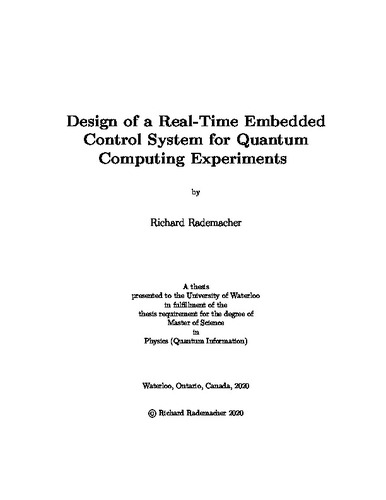| dc.description.abstract | This thesis describes the design of a real-time control system for trapped ion quantum computer experiments. It is framed in the context of the QuantumIon project, a project at the University of Waterloo’s Institute for Quantum Computing that aims to provide a scalable, remote-operation ion trap for a wide variety of quantum research without the need for ‘expert’ ion-trap knowledge. The target users span the range of ion-trap researchers,algorithms researchers, performance benchmarking researchers, and quantum simulation researchers.The control system features a user programming language, remote access to a compiling server, a sub-nanosecond time sequencing engine, arbitrary waveform generation for pulse shaping, and fully adjustable internal parameters. This platform affords the user extraordinary flexibility for many research use cases without requiring physical access. High-speed precision timing is achieved through the use of FPGA technology, while internal consistency (necessary for usability by non-experts) is achieved through an abstraction layer approach. Supercomputing-grade network infrastructure is employed to meet the strict timing requirements. An extensive suite of calibration tools and results is available to monitor machine-dependent parameters of the experiment. A sophisticated symbolic algebra system is used to create powerful calculations of precision timing sequences. Extensive automation is employed to remove the need for physical access, thus providing quantum computing to a wide audience. Under this model even the lowest-level control is avail-able to support innovative new designs, while a “library” of pre-defined sequences is also available to leverage “best practice” gates for those wishing rapid results. Finally, the user language itself is designed to be portable, allowing bindings to current popular classical languages such as Matlab and Python, and can be expanded for use in quantum-specific languages such as Cirq, Quill, and QASM .Through this approach the control system for QuantumIon is a flexible, powerful, scalable, and robust platform that is expected to be in use for a long time | en |

